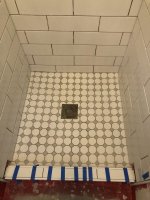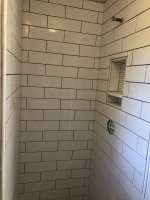Rdura
New Member
I have a 2x4 rough opening of approx 12 wide by 16 high. I am wanting to build a shower niche box to fit into this rough rectangle, and I wish to use left over materials, of which I will redgard with three light coats and seam tape. My options are 1/2 inch ply, or 1/4 inch hardybacker. I prefer the hardy as it gives me a bit more real estate inside the box. My concern is I wish to have a shelf in the box (covered top and bottom will ceramic tile). Is the hardybacker strong enough, i.e. will it deflect?
My idea for construction is: first affix the floor of the box. Then affix two side walls and a back wall about 4 inches in height. Then slot in the shelf so that it rests on the lip of each wall. Then two more side walls and a back wall, and a ceiling.
Yes, the lip isn't much, but I'm thinking the eventual 1/4 inch tile will provide more support from below.
Other option is build a plywood box in the garage with glue and nails. Push the entire box into the rough opening and affix. I'm not opposed to making the entire box out of ply, but using hardy for a shelf - I can route a slot for the 1/4 inch hardybacker. I like a thin shelf because I think (but not sure) once the shelf is sandwiched with 1/4 inch tile tile top and bottom, the face of the shelf will accept a pencil tile for trim.
Thank you, I am a DIYer and this is my first shower niche
My idea for construction is: first affix the floor of the box. Then affix two side walls and a back wall about 4 inches in height. Then slot in the shelf so that it rests on the lip of each wall. Then two more side walls and a back wall, and a ceiling.
Yes, the lip isn't much, but I'm thinking the eventual 1/4 inch tile will provide more support from below.
Other option is build a plywood box in the garage with glue and nails. Push the entire box into the rough opening and affix. I'm not opposed to making the entire box out of ply, but using hardy for a shelf - I can route a slot for the 1/4 inch hardybacker. I like a thin shelf because I think (but not sure) once the shelf is sandwiched with 1/4 inch tile tile top and bottom, the face of the shelf will accept a pencil tile for trim.
Thank you, I am a DIYer and this is my first shower niche


